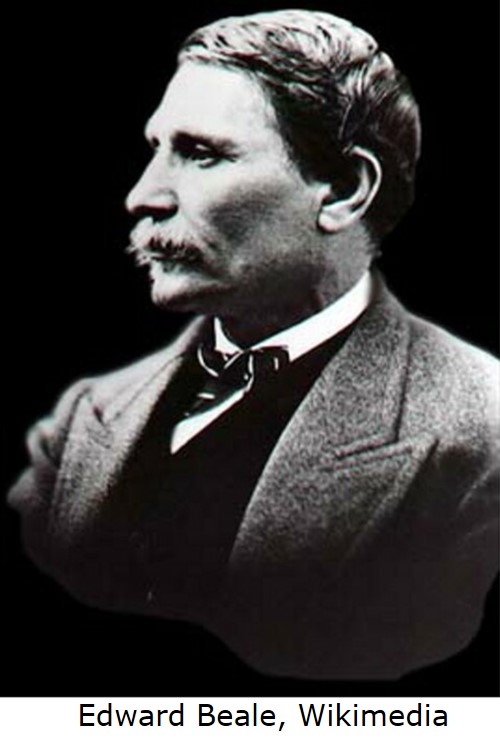By Suzanne Norquist
Imagine you're
traveling from Iowa to California by wagon train. The year is 1858. Although
many take the Oregon Trail, your party chooses a new route to the south that
passes through Santa Fe. Your family doesn’t want to face the unrest in the
north.
Your wagon rambles through the high desert in the heat. Then, you see a towering rock on the horizon. When you reach it, you find shade and an oasis of cool water. Once refreshed, you notice inscriptions on the rock wall—names of those who have stopped here before. Some are dated back to the 1600s. Even older are the petroglyphs.
This happened to thirteen-year-old Sallie Fox. She added her name to the wall, as did others from her party. The rock structure now stands in El Morro National Monument in western New Mexico.
In 1906, President Theodore Roosevelt signed the Antiquities Act to preserve historic monuments. Those who lived around the stone structure, known as Inscription Rock, lobbied for its preservation. El Morro was the second national monument created in the nation.
For
centuries, the rock tower beckoned travelers to enjoy its shade and water.
Petroglyphs indicate that Native Americans lived in the area for hundreds of
years. Ruins of an ancient pueblo, which dates back to 1275, sit within the
monument.
The earliest European inscription is dated April 16th, 1605. The translation from Spanish reads, "Here passed by the Governor-General Don Juan de Oñate, from discovery of the South Sea, April 16th, 1605." As the first governor of New Mexico, he was searching for "cities of gold."
Many other Spanish settlers, soldiers, and officials left their marks. Here is a particularly long one that appears to be another territorial general. It must have taken a while to carve all this in stone.
"I
am the captain General of the Providences of New Mexico for the King our Lord,
passed by here on the return from the pueblos of Zuni on July 29th the year
1620, and put them at peace at their humble petition, they asking favors as
vassals of his Majesty and promising anew their obedience, all of which he did,
with clemency, zeal, and prudence, as a most Christian-like (gentleman)
extraordinary and gallant soldier of enduring and praised memory."
Others gave
mainly names and dates.
"We
passed by here the Sargent Major and Captain Juan de Archuleta and the Adjutant
Diego Martin Barba and the Ensign Augustin de Ynojos, the year of 1636"
Here is one of the later Spanish ones.
"Here
was the General Don Diego de Vargas, who conquered for our Holy Faith, and for
the Royal Crown, all of New Mexico at his own expense, in the year of 1692"
After that,
there wasn't much interest in the area until New Mexico became a US Territory.
Then Lieutenant Edward Beale led an army expedition to survey a wagon road from
Fort Smith, Arkansas, to California. This is the southern route taken by Sallie
Fox.
The lieutenant brought a team with camels since they could travel through deserts for days without water. They were known as the "U.S. Army Camel Corps." They all carved their names into Inscription Rock. The Camel Corps was a short-lived experiment.
Travelers used the route until 1883 when a train track was built twenty-five miles to the north. Many left their mark, hoping to be a small piece of history.
The National
Park Service took over the site upon its creation in 1916. The service built a
contact station for visitors, which also served as a ranger cabin.
At this remote site, the oasis still offers cool refreshment, and the rock still displays the inscriptions. If the early settlers in 1858 had taken the Oregon Trail route, they would have missed this marvel of nature, and we would have never heard of a teenager named Sallie Fox.
***
" Mending Sarah's Heart" in the Thimbles and Threads Collection
Four
historical romances celebrating the arts of sewing and quilting.
Mending
Sarah's Heart by Suzanne Norquist
Rockledge,
Colorado, 1884
Sarah
seeks a quiet life as a seamstress. She doesn't need anyone, especially her
dead husband's partner. If only the Emporium of Fashion would stop stealing her
customers, and the local hoodlums would leave her sons alone. When she rejects
her husband's share of the mine, his partner Jack seeks to serve her through
other means. But will his efforts only push her further away?
Suzanne Norquist is the author of two novellas, "A Song for Rose" in A Bouquet of Brides Collection and "Mending Sarah's Heart" in the Thimbles and Threads Collection. Everything fascinates her. She has worked as a chemist, professor, financial analyst, and even earned a doctorate in economics. Research feeds her curiosity, and she shares the adventure with her readers. She lives in New Mexico with her mining engineer husband and has two grown children. When not writing, she explores the mountains, hikes, and attends kickboxing class.













Thanks for telling us about El Morro. That would be amazing to see.
ReplyDelete